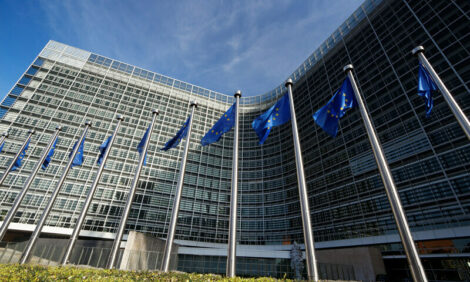



Bioniche in Stand-Off with APHIS Over <i>E. coli</i> Vaccine
US - Bioniche Life Sciences, Inc., an Ontario-based biopharmaceutical firm, is in a tense impasse with APHIS over its rejection of a vaccine that the company says can reduce the shedding of E. coli O157:H7 in cattle.|
E. coli
|
“We have a Mexican standoff right now,” Bioniche president and CEO Graeme McRae told Food Chemical News. “The USDA is saying ‘no,’ we don’t have enough evidence of efficacy, and we’re saying we do.”
In 1995, a Canadian researcher at the University of British Columbia made the original discoveries that led to the vaccine. McRae said that Bioniche became a commercial partner in 2000, and has invested nearly $20 million in the vaccine. Last year, the Canadian Food Inspection Agency approved distribution of the vaccine under its Permit to Release, a sort of conditional license that allows cattle owners, through their veterinarians, to request that the vaccine be supplied to them through Bioniche. There are a handful of herds receiving the vaccine in Canada, while regulators there review more efficacy data to determine whether to grant full registration.
If approved in the United States, it would be the first major pre-harvest intervention against the pathogen, the point along the food safety continuum that has received the least attention. Today’s interventions against E. coli O157:H7 occur mostly in packing plants; the promise of a vaccine is that it would help tackle the problem at its root.
In fact, at a Nov. 7 House Agriculture Subcommittee hearing on meat recalls, when Under Secretary for Food Safety Richard Raymond was asked for his opinion on the most significant way to reduce the pathogen, he said by eliminating it in the animal—through vaccines or bacteria phages.
Last month’s rejection of Bioniche’s application, which asked for approval of the vaccine to be used “as an aide in the reduction of shedding of E. coli O157,” has puzzled the company as well as others. There isn’t a precedent; it wasn’t until relatively recently that a determination was made over who would even regulate these new types of vaccines. APHIS’ Center for Veterinary Biologics was chosen. Bioniche is “asking for the lowest allowed claim on a vaccine,” said Gary Weber,
a consultant working with the company who formerly was with the National Cattlemen’s Beef Association. The vaccine isn’t a silver bullet, and it wouldn’t be marketed as “preventing” shedding of E. coli O157. But it would help reduce the higher loads of the pathogen that occur during the warm summer months. “By converting summer prevalence into more like winter prevalence, plants’ interventions will be more capable of preventing contamination. They get overwhelmed in the summer,” he said.
Weber added that “it’s candidly mind-boggling that there would be this much of a problem. The leadership at USDA needs to step up.” It’s impossible to ascertain APHIS’ thinking on the issue, as spokeswoman Karen Eggert could not comment on the agency’s decision. “We are not allowed to provide information on potential licensees,” she said. “We are unable to even confirm or deny that they’ve applied for a license. Under confidential business information, we keep all details of the licensing process confidential. Our hands are tied in that we can’t divulge anything about the company or any discussions made about the vaccine.”
Another tantalizing aspect of the brouhaha is that two studies were published in this month’s Journal of Food Protection demonstrating the vaccine’s efficacy. The research was conducted by the University of Nebraska, which has been involved in the project since the get-go, and Bioniche. Ironically, one of the studies was supported by funds provided by USDA, as well as Bioniche, the Nebraska Beef Council and the Hatch Act.
That study, a clinical trial of 688 steers, showed a vaccine efficacy of 68%, 66% and 73% among animals receiving one, two and three doses respectively, compared with cattle not receiving the vaccine. The study also showed that vaccinating a majority of the cattle within a pen offered a significant protective effect, or herd immunity, to unvaccinated cattle within the same pen. The other study, a blinded clinical trial involving 288 feedlot steers, showed that vaccinated cattle were 98.3% less likely to be colonized by E. coli O157:H7 in their terminal rectum mucosal (TRM) cells.
David Smith, one of the University of Nebraska co-authors of the studies, said, “Together these studies provide important information about whether and how this vaccine works in field conditions. We gain confidence that the vaccine is effective by seeing that it reduces fecal shedding and colonization of cattle with E. coli O157:H7, observing the phenomena of herd immunity, and noticing that greater numbers of doses increased the effect.”
Meanwhile, Bioniche representatives met with APHIS officials last week to discuss the statistical designs of all the company’s research, of which the government apparently has a difference of opinion. Bioniche even brought in statistician George Milliken, professor emeritus at Kansas State University, to support its analysis.
“USDA statisticians didn’t offer a single argument to effectively refute Milliken,” said Weber, who attended the meeting. “They say the data don’t support the conclusions, but there are years of research on this.”
Weber said that he remembers when FSIS was similarly reluctant in the 1990s about approving in-plant interventions. But Weber said that he is convinced that USDA is just as wrong about this as they were about the plant interventions, and that APHIS doesn’t seem to understand the sophistication of the agriculture business.
“I guarantee you that nobody will pay for a vaccine twice that doesn’t show reductions [of E. coli O157:H7] in the summer,” Weber said. “This is measurable, it will be documented. Let the industry make the final decision in the marketplace,” he said. “APHIS just seems to be stuck in the mud on this deal.”
TheCattleSite News Desk


